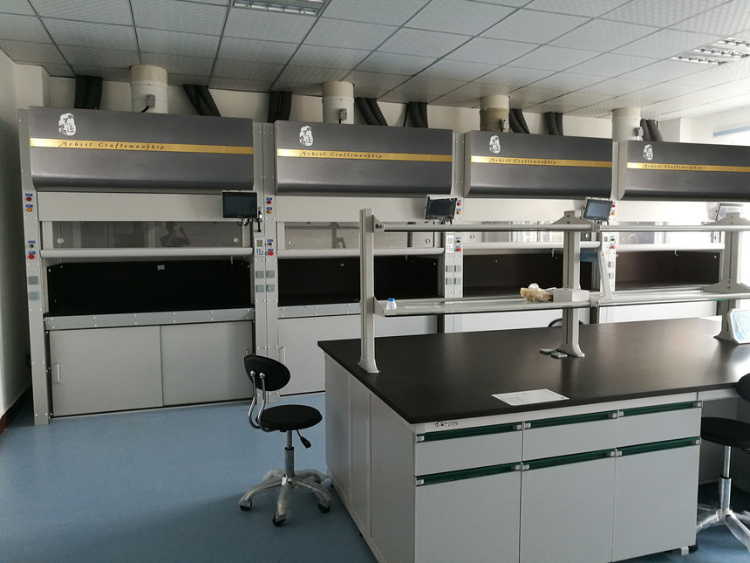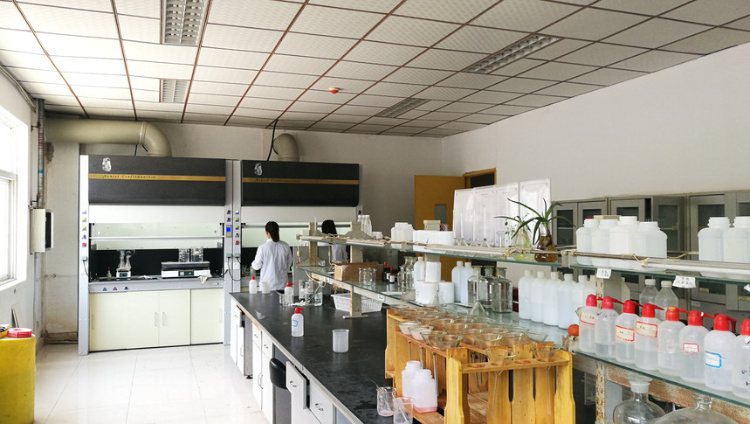Chengdu Ample Import And Export Co., Ltd. |
A fume hood is a special type of laboratory work equipment with an
enclosure on top that can contain the effects of the experiment
being run within it. It is designed to ensure safety for the user
and other inhabitants of the room, and it should be able to filter
out any harmful gasses. A fume hood may also provide protection
from small explosions or splashes. It must have a built-in
mechanism to strongly suck the gasses out of the working area
within the enclosure.
Basically, a fume hood is just a large box on top of a lab workbench. This box has a large door or shutter at one side, and may or may
not have glass or CRCA sheet walls on other sides. If you need to
display some dangerous kind of experiment to an audience on top of
an island-type lab table, then you need a glass-walled chamber; or
else a wall-facing metal fume cabinet is fine.
Ductless fume cupboards don't have a vent, but have a large filter unit mounted on top in front of the fan. The blower inside sucks in air from the room through the front opening, takes the gasses or fumes inside the box, and passes them through the filter, finally throwing the filtered air into the room again.
The filter unit in a ductless fume hood consists of two phases the pre-filtration layer which can be just thick foam, catching all the large particles. After that comes the large main filter which is generally an activated carbon shield absorbing most gasses (but not ammonia and carbon monoxide). With normal usage, the foam may work for 6-8 months and the carbon filter may last up to 2 years. Note that these may need to be changed according to the kind of fumes you expect to rise out of your experiment.
| Model Specification | WJ-1500A | WJ-1500B | WJ-1800A | WJ-1800B |
| External dimensions of equipment(mm) | 1500(W)*1205 (D) *2400 (H) | 1800(W)*1205 (D) *2400 (H) | ||
| Dimension of works pace (mm) | 1260(W1)*780(D1) *1100 (H1) | 1560(W1)*780(D1) *1100 (H1) | ||
| Panel material | 20+6mm thick butterfly ceramics | |||
| Material of internal lining board | 5mm thick ceramic fiber board | |||
| Diversion structure | Lower air return | |||
| Control system | Button control panel (LCD panel) | |||
| PH value control | The medium is alkaline water solution; manual monitoring, and manual control through acid pump and alkali pump. | |||
| Input power | Three-phase five-wire 380V/50A | |||
| Current for air fan | Not over 2.8A(380V or 220V can be directly connected) | |||
| Maximum load of socket | 12 KW(total of 4 sockets) | |||
| Water tap | 1 set (remote control valve + water nozzle) | No | 1 set (remote control valve + water nozzle) | No |
| Water discharge way | Magnetic chemical pump strong discharge | |||
| Using environment | For non-explosion indoor use, within 0-40 degrees Celsius. | |||
| Applicable fields | Inorganic chemistry experiment; Food, medicine, electronics, environment, metallurgy, mining, etc. | |||
| Ways of Purification | Spray sodium hydroxide solution, no less than 8 cubic meters/hour | Spray sodium hydroxide solution.no less than 12 cubic meters/ hour | ||
| Ways of surface air speed control | Manual control (through the electric air valve to adjust the exhaust air volume or adjust the height of the moving door) | |||
| Average surface air speed | 0.6-0.8 m/s Exhaust air volume: 1420-1890m3/h (when door height h =500mm) | 0.6-0.8 m/s Exhaust air volume: 1760-2340m3/h (when door height h =500mm) | ||
| Speed deviation of surface air | Not higher than 10% | |||
| The average intensity of illumination | Not less than 700 Lux; Standard white and uv-free yellow LED lamps; The illumination is adjustable. | |||
| Noise | Within 55 decibels | |||
| Flow display | White smoke can pass through the exhaust outlet, no overflow. | |||
| Safety inspection | No spikes, edges; Charged body and the exposed metal resistance is greater than 2 mQ; Under 1500V voltage, no breakdown or flashover occurred for 1min test. | |||
| Resistance of exhaust cabinet | Less than 160 pa | |||
| Power consumption | Less than 1.0kw/h (excluding power consumption of fans and external instruments) | Less than 1.2kw/h (excluding power consumption of fans and external instruments) | ||
| Water consumption | Less than 3.2L/ h | Less than 4.0L/ h | ||
| Performance of wind compensation | With a unique wind compensation structure, the volume of the wind will not cause turbulence in exhaust cabinet and will not directly blow to the staff (need to connect to the air compensation system of the laboratory) | |||
| Air volume regulating valve | 315mm diameter flanged type anti-corrosion electric air flow regulating valve (electric contact actuator) | |||
1.
All operations that may generate hazardous air contaminants must be done inside a laboratory fume hood.
2.
Fume hoods do not prevent accidents or chemical splashes.
3. Hood users must be trained in the proper operation and use of laboratory fume hoods.
4.
The hood should not be operated unless it is verified that it is working correctly.
5. Safety glasses (goggles), lab coats,
and appropriate chemical gloves must be worn when
working in, on, or around the fume hood.
6. Do not put your head in the hood,
beyond the sash opening.
7. Do not use the hood for storage of equipment,
containers, or chemicals which are not going to
be used during the day.
8.
Equipment and materials placed in the hood must not block hood slots,
airfoils, or otherwise interfere with
the smooth flow of air into the hood.
9. Never place or use equipment that protrudes beyond the face of the hood (sash opening).
This configuration
will disrupt air flow of air into the
hood and reduce its efficiency.
10.
Keep all equipment and materials at least 6
inches behind the plane of the sash (hood
face), this will improve containment capture.
A stripe (tape) on the hood working surface is a good
reminder.
11.
Place all bulky equipment away from the sidewalls to allow air flow around the equipment.
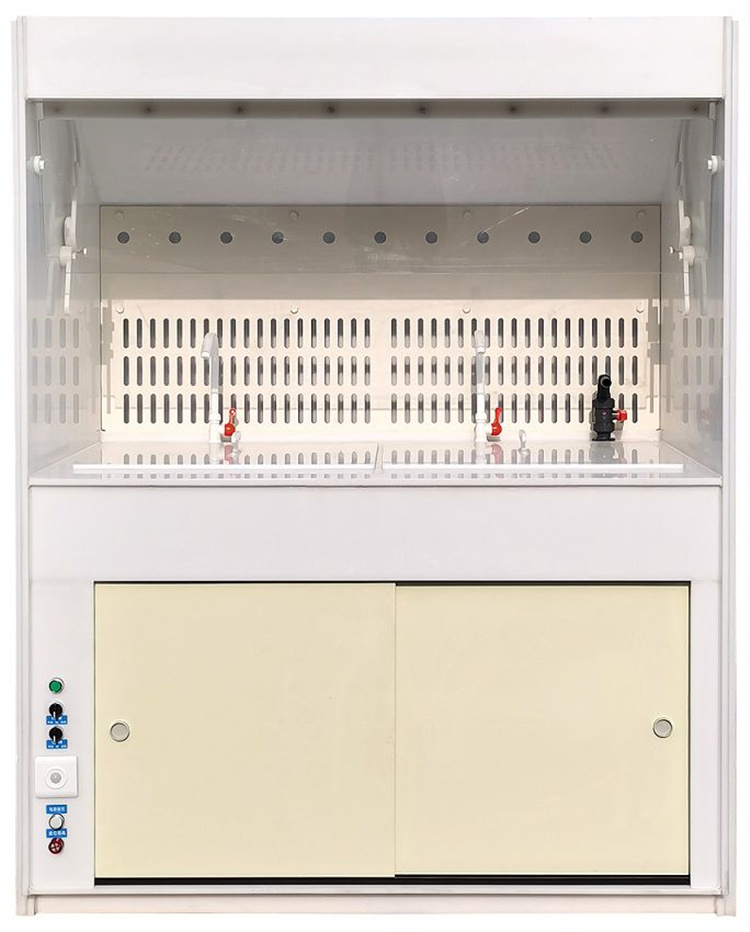
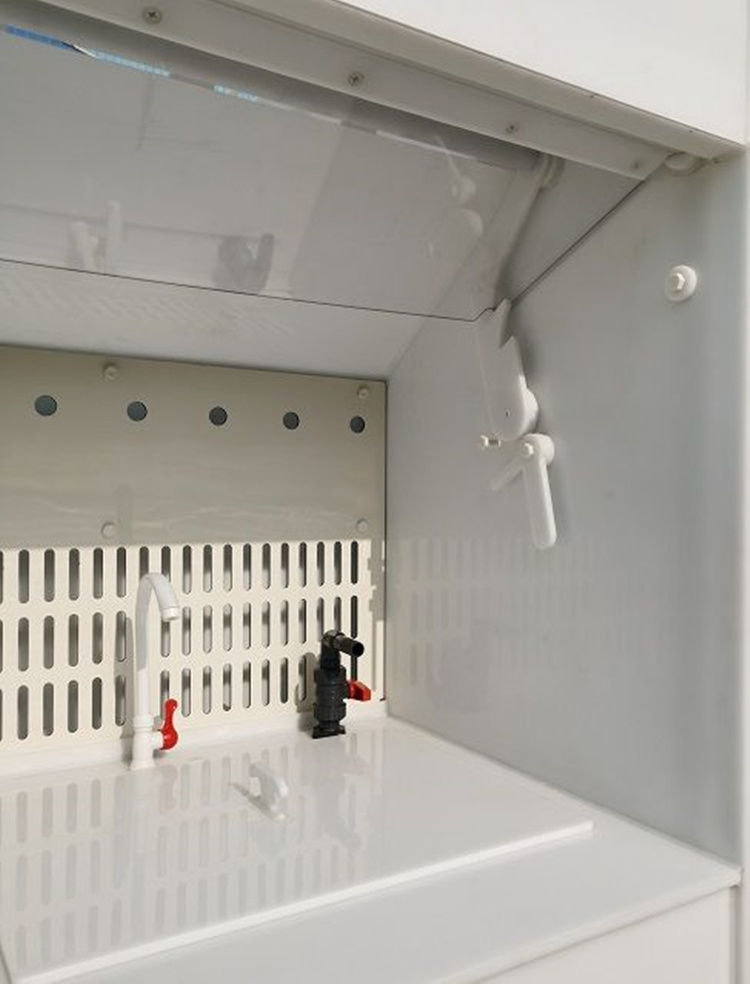
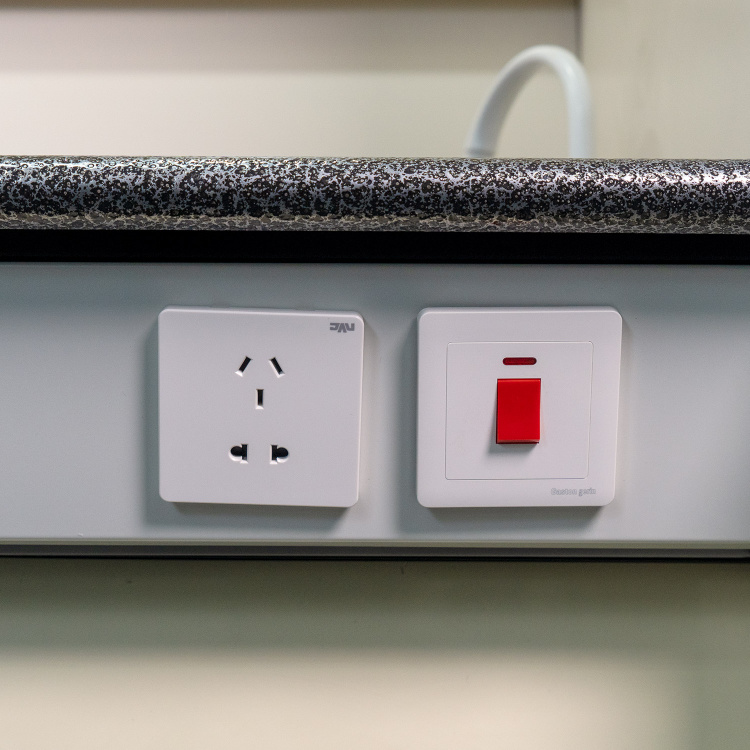
Inside the fume hood, there are facilities to let you work. For
example, there is almost always some good lighting system in the
cabinet. There should be LPG and water connections in the hood, and
a drain too in case of spills.
The air suction system is generally placed on top of the box or on
the backside (the side towards the wall). This system is generally
made up of a strong exhaust fan or air pump and accompanying air
duct. The strength of the pump lies in the airflow strength
starting from 4 to 8 meters per second to more.
When the exhaust is running, it sucks in volumes of air through the
open side (never run the exhaust with the hood completely closed)
and vents it through the duct. The duct may throw the fumes right
outside the room in the air, or may run it through a filtration
system, depending upon the severity of the experiment.
Some advanced laboratory fume hoods have microcontrollers inside
them, which you can use to control the exhaust. You may set various
suction levels for given setups and later use these quick setups
for particular experiments. You can also control the fan/pump power
during the experiment too, and the lights as well. The control
panel can also warn you about various inconsistencies, like the
presence of smoke or fire or too high a shutter
